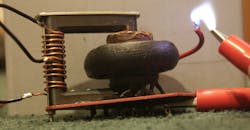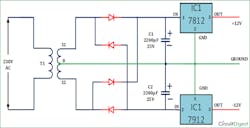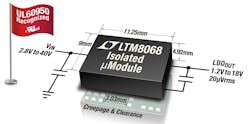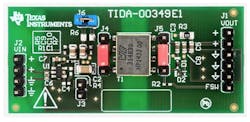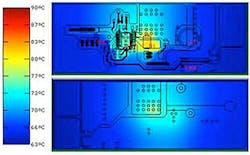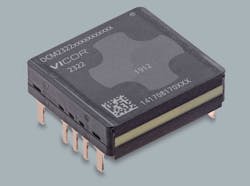This article is part of the TechXchange: Exploring Digital Isolator Technology
Often you need to take a measurement from an isolated sensor. The classic way to do this was to send the analog signal across the isolation boundary, perhaps with an optocoupler or an instrumentation amplifier. Another way to send analog across an isolation boundary is with a delta-sigma modulator. You can also use these techniques in isolated power supplies to bring an output feedback voltage back to the primary side.
More recently, the advent of high-performance inexpensive digital isolators means that you can digitize your sensor measurement and send the value back across the isolation boundary as a digital data stream. Consequently, you now must send appreciable power across the isolation boundary to run the analog-to-digital converter (ADC) on the isolated side.
Three common ways to send power across an isolation boundary are via capacitive, magnetic, or optical coupling. Capacitive coupling is less used; but with X- or Y-rated capacitors, you can send charge across your boundary for low-power application needs. Sending power with optical methods is rare, but can work for very high-voltage boundaries, where you can use a foot of optical fiber to get a mega-volt of isolation. A much more common approach is to use magnetics to send power across your isolation boundary.
Using Magnetic Coupling
The ancient and classic way is to send ac across a boundary is with a linear transformer (Fig. 1). To make your life easier, you should use a transformer with a UL and other safety agency listings. This will not make your product UL listed, but it becomes much easier to get that listing when you submit your design to a testing agency.
1. You can use a linear transformer to make an isolated power supply. (Courtesy of circuitdigest.com)
To get a space, weight, and cost advantage, you can use an isolated ac-dc switching power supply. This is just a subset of the supplies that you use to make wall voltage into dc voltages for powering your electronic systems. If you only need to power a sensor, you might have trouble finding an ac-dc power supply or reference design with a low enough power.
This is where power modules can come in handy. They come in ac-dc versions as well as isolated dc-dc modules that might be ideal to power a sensor or actuator subsystem across an isolation boundary. First popularized by Linear Tech (now Analog Devices) with its µModules (Fig. 2), as well as those made by Enpirion (now Intel), modules are a great way to “drop in” a power solution that requires a minimum of engineering.
2. Analog Devices has an extensive series of isolated modules that can be dropped into your design. (Courtesy of Analog Devices)
Modules are also available from Intersil/Renesas, Texas Instruments, Murata, MPS, ROHM, and CUI, amongst other vendors in this growing market. Like UL listing on a linear transformer, UL or EU listings of a module will not mean you can claim your product is listed—you must submit to a testing agency. One of the key things you can submit is the listing and compliance to standards of the component parts, which makes it faster and cheaper to get your agency approvals.
Isolated Switching Regulators
Depending on your volume needs and market requirements, you may find modules more expensive than you prefer. Therefore, you have to design an isolated converter. In this case, you can look at switching regulator chips meant for isolated power. The thing to look for is an evaluation or demo board design offered by the manufacturer or a third party (Fig. 3). While these are rarely UL or CE listed themselves, if they use a UL-listed transformer, it makes obtaining agency approvals simpler, much like using a listed linear transformer in your design.
3. TI offers the TIDA-00349, a uniquely efficient isolated dc-dc converter reference design that can be used directly in your design for evaluation purposes. (Courtesy of Texas Instruments)
Best yet, you can often hack in the demo board into your prototype, allowing for immediate evaluation of your isolated power system. Once you’re satisfied, you can incorporate the schematic and layout into your final design. The chip vendors usually have the eval board as an open system, with schematics, Gerber files, layout files, and bills-of-material available for download on their websites.
Texas Instruments offers its WEBENCH online design tool, which will let you evaluate different designs in a virtual environment, and even provide you a simulated thermal analysis (Fig. 4). Analog Devices’ LTSpice free downloadable simulation package is tailored to give good results with switching power supplies.
4. Online design tools like TI’s WEBENCH simulation environment will even give a thermal map of your design. (Courtesy of Texas Instruments)
The Many Ways to Isolation
As with all analog problems, your approach is dictated by your application. Perhaps you can spec a listed transformer with an extra winding for your isolated subsystem. Some engineers just use an open-loop oscillator and a pulse transformer to send a little power over an isolation boundary. A module is a great way to leverage the analog expertise of the semiconductor companies.
When designing your own isolated switching converter, online tools and demo boards make it a much simpler goal. Decades ago, many digital engineers were delighted when they saw they could use Texas Instruments’ Simple Switcher line of converter designs to make a non-isolated power system. Doing an isolated supply is more complex, but the vendors have provided us with everything from drop-in modules to proven evaluation boards augmented with Spice and online design tools.
Risk and Reward
Your approach may be dictated by your risk tolerance. Years ago, in the auto business, Ford tended to design things cheap, and then add cost until things worked. GM designed things to work, then took cost out until the company hit its financial goals. That’s a less risky way to design things. Missing cost targets might disappoint the accountants or stockholders, but if you fail UL testing, you can’t sell your product, and that’s much worse than a cost overrun.
You might start your design using a stable quiet laboratory supply to evaluate your design. Then, as soon as you can, put in high-performance modules, perhaps similar to what Vicor makes with zero-voltage switching and good common-mode noise performance (Fig. 5). They’re expensive, but you get what you pay for.
5. Vicor offers the DCM2322 module family, which is a complete solution with very good specifications. (Courtesy of Vicor)
If your system works okay, you can try cheaper modules, or, if you have the time, do a custom design based on a demo board that you evaluate. You could also leave some extra room around a module with the hope that in future design cycles, a cheaper isolated switching regulator of your own design could be integrated. No matter your approach, be sure to test and evaluate the power system, so that your customers don’t have any nasty surprises or shattered expectations.
About the Author

Paul Rako
Creative Director
Paul Rako is a creative director for Rako Studios. After attending GMI (now Kettering University) and the University of Michigan, he worked as an auto engineer in Detroit. He moved to Silicon Valley to start an engineering consulting company. After his share of startups and contract work, he became an apps engineer at National Semiconductor and a marketing maven at Analog Devices and Atmel. He also had a five-year stint at EDN magazine on the analog beat. His interests include politics, philosophy, motorcycles, and making music and videos. He has six Harley Sportsters, a studio full of musical instruments, a complete laboratory, and a video set at Tranquility Base, his home office in Sun City Center Florida.
